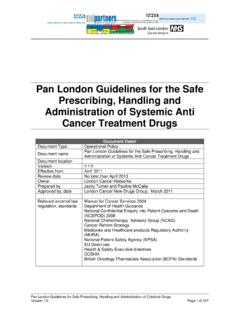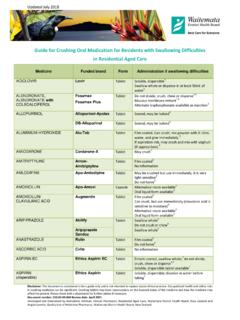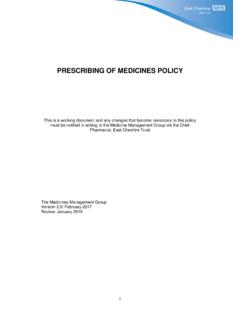Transcription of Antioxidant and cytotoxic activity of Tecoma stans against ...
1 Braz. J. Pharm. Sci. 2017;53(3):e00204 Page 1 / 5 Brazilian Journal of Pharmaceutical *Correspondence: J. P. Robinson. Department of Biotechnology. College of Technology. Trichengode, Namakkal District. Tamil Nadu, India. E-mail: and cytotoxic activity of Tecoma stans against lung cancer cell line (A549)Jayachandran Philip Robinson*, Kumaresan Suriya, Ramasamy Subbaiya, Ponnusamy PonmuruganDepartment of Biotechnology, College of Technology, Trichengode, Tamil Nadu, IndiaHuman have been constantly using plants and plant products to overcome many diseases. The Antioxidant property of the plant sources is studied to obtain an efficacious drug against cancer.
2 The objectives of the present study is to evaluate the Antioxidant and cytotoxic activity of the Tecoma stans extracts against lung cancer cell line in comparison with vincristine drug. The Antioxidant activity was studied using the standard DPPH assay and the cytotoxic activity using MTT assay. DPPH assay results show that methanolic extract of T. stans in higher concentration show better Antioxidant potential than the standard L-ascorbic acid. They exhibited strong Antioxidant potential at 20 g/mL concentration. The absorbance at 517 nm showed that in the range of compared to that of absorbance of ascorbic acid at activity was studied using MTT assay which showed that the increase in concentration of extract increases the cell death.
3 At 100 g/mL concentration there is an increased cytotoxic activity , , 99% of cell inhibition. The results of Antioxidant and anticancerous activity may be positively : Tecoma stans /extract/cytotoxicity. Tecoma stans /extract/ Antioxidant activity . Free radical scavenging. Plant extracts. Lung cancer cell line/ is one of the disease that occurs in both developed and developing countries and is the leading cause of death. An extensively used treatment for cancer is chemotherapy and one of the major drawbacks is the toxicity that is caused to the normal cells due to the inability of the chemical drugs to differentiate between normal and cancerous cells (Balamurugan et al.)
4 , 2014). Traditional medicines have been tested and researched upon to obtain an effective drug against cancer. Plant derived compounds are widely studied for their holistic value. These plant derived compounds have clinical significance which can be further developed into effective drugs against cancer. Bio active compounds have received the attention of researchers to overcome the burden of chemotherapy related problems. Oncovin is the brand name for vincristine, which is used as a chemotherapy drug for many types of cancer. Vincristine is also used to treat neurodegenerative disease (Chun-Fai et al.
5 , 2013). The mode of action of vincristine is that it acts on the tubulin protein, thereby inhibiting the metaphase stage, thus leading the cell to apoptosis (Jordan, 2002). Tecoma stans is an ornamental tree that has its origin from the Americas belongs to the family Bignoniaceae. Presently the plant is widely cultivated throughout India for its flowers which bloom throughout the year. Presence of alkaloids tecomine and tecostamine which are potential hypoglycemic agents present in the leaves of T. stans . In addition to that presence of also anthranilic acid in the roots of plant which is an antidiabetic agent (Khare, 2007).
6 There are a number of compounds from the fruits and flowers of the Tecoma , which had Antioxidant activity and anti proliferative effect against cancer cell lines (Marzouk et al., 2006). Antioxidants play a major role in deciding the pharmaceutical effect of plants and to make them potent drugs against the chronic diseases. These antioxidants are taken in our dietary from the plant compounds, which is a rapid and simple method. The DPPH assay is the simple method to evaluate the presence of antioxidants in any source based on the principle of radical scavenging activity . In this assay the (2, 2-diphenyl-1-picryl-hydrazyl-J.)
7 P. Robinson, K. Suriya, R. Subbaiya, P. PonmuruganBraz. J. Pharm. Sci. 2017;53(3):e00204 Page 2 / 5hydrate) , DPPH is reduced to DPPHH, the odd element is formed is absorbed at 517nm (Tailor, Goyal, 2014). The cytotoxic activity of the plant extract is studied using the 3-(4,5-dimethylthiazol-2-yl)-2,5- diphenyltetrazolium bromide (MTT) which forms formazan (insoluble) crystals, by interacting with the mitochondria of the cells and the insoluble formazan that is formed is solubilized using isopropanol solvent which is studied spectrophotometrically at 540 nm. MTT is reduced only by metabolically active cells, thus in, turn it helps to study the viability of the AND METHODC ollection of plant materialThe fresh plant of Tecoma stans was collected from Paramathi velur, Namakkal district of Tamil Nadu, India.
8 The collected plants were further surface sterilized using tween 80 and it was shade dried for future investigation. Preparation of plant extract10 g of both fresh and dried leaves, flowers were chopped into fine pieces and macerated in 100 mL of methanol. The plant material was extracted at room temperature for 3 days in a shaker. The extract was filtered and the filtrate was concentrated in a rotary evaporator under reduced pressure to dryness. The extract obtained was stored at 4 oC until assayDPPH assayThe percentage of Antioxidant assay was determined using the free radical scavenging activity (2, 2-diphenyl-1-picryl-hydrazyl-hydrate).
9 About 1 mg of fresh and the dried plant extracts was dissolved in 1ml of methanol. The standard procedure for DPPH assay was performed based on Ochuko et al. (2012). About 10 mL of mM of DPPH was prepared in methanol and stored in cool dark condition until use. Accurately, 1 mL of DPPH was added to different concentration (20, 40, 60, 80, 100 g/mL) of extract. The mixture of DPPH and extract was shaken and incubated at room temperature in the dark for 30 minutes, then the absorbance was measured at 517 nm in the UV spectrophotometer (Tailor, Goyal, 2014). Ascorbic acid was used as a reference and DPPH without the extract served as negative control.
10 The IC50 value of the sample was calculated based on the absorbance. The percentage of inhibition was calculated using the formula,DPPH scavenging effect (%) or Percent inhibition = (Absorbance of sample-absorbance of blank)/Absorbance of Control X 100 Lung Cancer (A549) cell lineLung cancer cell line (A549) cell line was procured from NCCS, Pune and maintained in Dulbecco s minimal essential medium (DMEM) with 10% FBS, and antibiotic mixture (Penicillin, streptomycin and ampicillin 100 units/mL) under defined conditions of temperature at 37 oC, 95% humidity and 5% CO2. Cell viability assayThe cytotoxic activity of the fresh and dried extracts of leaves and flowers of Tecoma stans was determined using the 3-(4,5-dimethylthiazol-2-yl)-2,5- diphenyltetrazolium bromide (Terry et al.)


















